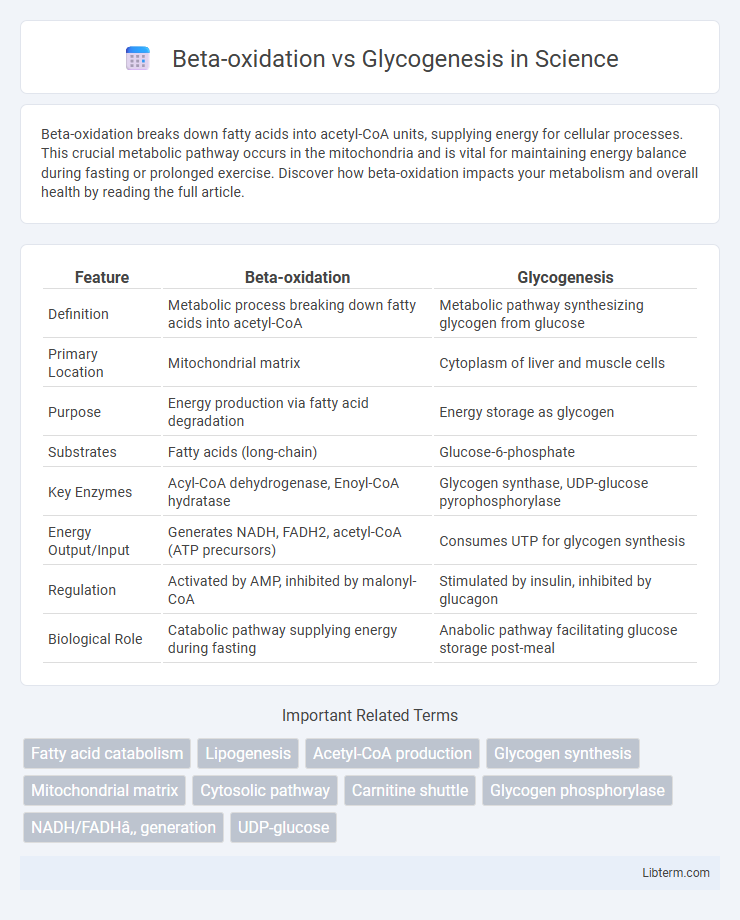Beta-oxidation breaks down fatty acids into acetyl-CoA units, supplying energy for cellular processes. This crucial metabolic pathway occurs in the mitochondria and is vital for maintaining energy balance during fasting or prolonged exercise. Discover how beta-oxidation impacts your metabolism and overall health by reading the full article.
Table of Comparison
| Feature | Beta-oxidation | Glycogenesis |
|---|---|---|
| Definition | Metabolic process breaking down fatty acids into acetyl-CoA | Metabolic pathway synthesizing glycogen from glucose |
| Primary Location | Mitochondrial matrix | Cytoplasm of liver and muscle cells |
| Purpose | Energy production via fatty acid degradation | Energy storage as glycogen |
| Substrates | Fatty acids (long-chain) | Glucose-6-phosphate |
| Key Enzymes | Acyl-CoA dehydrogenase, Enoyl-CoA hydratase | Glycogen synthase, UDP-glucose pyrophosphorylase |
| Energy Output/Input | Generates NADH, FADH2, acetyl-CoA (ATP precursors) | Consumes UTP for glycogen synthesis |
| Regulation | Activated by AMP, inhibited by malonyl-CoA | Stimulated by insulin, inhibited by glucagon |
| Biological Role | Catabolic pathway supplying energy during fasting | Anabolic pathway facilitating glucose storage post-meal |
Introduction to Beta-oxidation and Glycogenesis
Beta-oxidation is the metabolic process that breaks down fatty acids into acetyl-CoA units within the mitochondria, supplying energy during periods of fasting or increased energy demand. Glycogenesis is the anabolic pathway converting glucose into glycogen for storage primarily in liver and muscle cells, maintaining blood glucose levels and energy reserves. Both pathways play critical roles in cellular energy management, with beta-oxidation facilitating lipid catabolism and glycogenesis enabling carbohydrate storage.
Overview of Energy Metabolism
Beta-oxidation is a metabolic process that breaks down fatty acids into acetyl-CoA, fueling the Krebs cycle and producing substantial ATP through oxidative phosphorylation. Glycogenesis, in contrast, stores glucose as glycogen, serving as an energy reserve that can be mobilized when glucose levels drop. Together, these pathways balance energy production and storage, optimizing cellular metabolism based on nutrient availability and energy demands.
What is Beta-oxidation?
Beta-oxidation is the metabolic process by which fatty acids are broken down in the mitochondria to generate acetyl-CoA, which enters the citric acid cycle for ATP production. This catabolic pathway involves the sequential removal of two-carbon units from the fatty acid chain, producing NADH and FADH2 for the electron transport chain. Beta-oxidation is essential for energy production during prolonged fasting or intense exercise when carbohydrate stores are limited.
Steps Involved in Beta-oxidation
Beta-oxidation involves the systematic breakdown of fatty acids in the mitochondria through four main steps: dehydrogenation by acyl-CoA dehydrogenase, hydration by enoyl-CoA hydratase, a second dehydrogenation by hydroxyacyl-CoA dehydrogenase, and thiolysis by beta-ketothiolase, resulting in the production of acetyl-CoA. This biochemical pathway contrasts with glycogenesis, which is the anabolic process of synthesizing glycogen from glucose. Beta-oxidation primarily generates energy by producing acetyl-CoA for the citric acid cycle, while glycogenesis serves as a glucose storage mechanism in liver and muscle cells.
What is Glycogenesis?
Glycogenesis is the metabolic process through which glucose molecules are converted into glycogen for storage primarily in liver and muscle cells. This pathway involves key enzymes such as glycogen synthase, which facilitates the formation of a-1,4-glycosidic bonds to elongate the glycogen chain. Unlike beta-oxidation that breaks down fatty acids for energy production, glycogenesis serves as a mechanism to regulate blood glucose levels and provide an energy reserve during periods of fasting or high energy demand.
Key Phases of Glycogenesis
Glycogenesis involves three key phases: glucose phosphorylation by hexokinase or glucokinase, formation of UDP-glucose via UDP-glucose pyrophosphorylase, and elongation of the glycogen chain catalyzed by glycogen synthase. This process stores glucose as glycogen in liver and muscle cells. Beta-oxidation, by contrast, breaks down fatty acids into acetyl-CoA units for energy production, highlighting distinct metabolic pathways for carbohydrate storage versus lipid catabolism.
Beta-oxidation vs Glycogenesis: Metabolic Roles
Beta-oxidation and glycogenesis play distinct metabolic roles in energy management, with beta-oxidation breaking down fatty acids into acetyl-CoA for ATP production during fasting or energy demand. In contrast, glycogenesis converts glucose into glycogen for short-term energy storage primarily in liver and muscle tissues. This balance between lipid catabolism and carbohydrate storage ensures cellular energy homeostasis under varying physiological conditions.
Regulation and Enzyme Control
Beta-oxidation is regulated primarily by the availability of fatty acids and the activity of carnitine palmitoyltransferase I (CPT1), which is inhibited by malonyl-CoA, linking fatty acid synthesis and degradation. Glycogenesis is controlled by glycogen synthase, whose activity is modulated by phosphorylation through glycogen synthase kinase and dephosphorylation by protein phosphatase 1, responding to insulin and glucose levels. The reciprocal regulation between these pathways ensures metabolic balance, with AMP-activated protein kinase (AMPK) playing a central role in shifting cellular energy status toward either fat oxidation or glycogen storage.
Physiological Significance and Differences
Beta-oxidation breaks down fatty acids into acetyl-CoA, providing a major energy source during fasting or prolonged exercise, while glycogenesis stores excess glucose as glycogen primarily in the liver and muscle for rapid energy release. Beta-oxidation occurs in mitochondria and involves sequential removal of two-carbon units, whereas glycogenesis takes place in the cytoplasm through enzyme-mediated polymerization of glucose. The key physiological difference lies in energy utilization: beta-oxidation fuels sustained energy production during low carbohydrate availability, whereas glycogenesis supports immediate energy demands by maintaining blood glucose homeostasis.
Clinical Relevance and Disorders
Beta-oxidation is crucial for energy production by breaking down fatty acids, and its impairment can lead to metabolic disorders such as Medium-chain acyl-CoA dehydrogenase deficiency (MCADD), causing hypoglycemia and muscle weakness. Glycogenesis involves the synthesis of glycogen from glucose, with defects in enzymes like glycogen synthase or branching enzyme resulting in glycogen storage diseases (GSD), characterized by hepatomegaly, hypoglycemia, and muscle cramps. Understanding these pathways aids in diagnosing metabolic conditions and tailoring treatments to manage energy imbalances in patients.
Beta-oxidation Infographic

 libterm.com
libterm.com